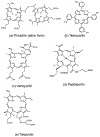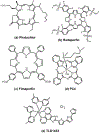Photodynamic Therapy for Cancer: What's Past is Prologue
- PMID: 31820824
- PMCID: PMC7282978
- DOI: 10.1111/php.13190
Photodynamic Therapy for Cancer: What's Past is Prologue
Abstract
Thomas J Dougherty from Roswell Park Cancer Center played a major role in the progress of photodynamic therapy (PDT) from a laboratory science into a real-world clinical therapy to treat patients with cancer. Nevertheless over the succeeding 45 years, it is fair to say that the overall progress of clinical PDT for cancer has been somewhat disappointing. The goal of this perspective article is to summarize some of the clinical trials run by various companies using photosensitizers with different structures that have been conducted for different types of cancer. While some have been successful, others have failed, and several are now ongoing. I will attempt to touch on some factors, which have influenced this checkered history and look forward to the future of clinical PDT for cancer.
© 2019 American Society for Photobiology.
Figures



References
-
- Raab O (1900) Uber die Wirkung fluoreszierender Stoffe auf Infusorien. Z Biol 39 524–546.
-
- Von Tappenier H (1900) Uber die Wirkung fluoreszierender Stoffe auf Infusorien nach Versuchen von O. Raab. Muench Med Wochenschr 47, 5.
-
- Jesionek A and von Tappenier H (1903) Therapeutische Versuche mit fluoreszierenden Stoffen. Muench Med Wochneshr 47, 2042–2044.
-
- Von Tappeiner H and Jodlbauer A (1904) Uber Wirkung der photodynamischen (fluorieszierenden) Stoffe auf Protozoan und Enzyme. Dtsch Arch Klin Med 80, 427–487.
-
- Von Tappeiner H and Jodlbauer A (1907) Die Sensibilisierende Wirkung fluorieszierender Substanzer Gesammte Untersuchungen uber die photodynamische Erscheinung. F. C. W. Vogel, Leipzig.
Publication types
MeSH terms
Substances
Grants and funding
LinkOut - more resources
Full Text Sources
Medical
Miscellaneous

